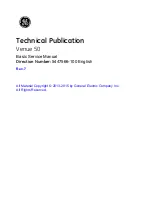
2
When mounting the Pacific on its pole or bracket. the
cable needs to be fed down through the mounting.
When arranging this cable make sure it cannot chafe at the
point where it leaves the mounting pole.
Either lead the cable out of the bottom of the pole in a
gentle curve or drill an exit hole in the pole large enough
to take a rubber grommet to protect the cable from the
sharp edges of the hole.
REGULATION
It is advisable to fit a Charge Control Regulator if the
Generator is regularly left to charge batteries where no
loads are present. Under these conditions over-charge will
slowly drive off the battery electrolyte which, if not
topped up, will eventually damage the batteries.
HANDLING
Stopping. The wind turbine has been designed to survive
storms, however, it is a good plan to stop the machine if a
hurricane is expected or to carry out inspection.
To do this, proceed with caution, approach the Pacific
from downwind and grasp the tail vane (use a boathook
for marine generators).
Carefully turn the machine off wind and, when the blades
stop, throw a rope over them and tie down.
Never throw a rope into the turning blades.
To avoid personal injury wear sturdy gloves as a
precaution. The wind turbine blades are capable of
causing GRAVE PERSONAL INJURY and should be
treated with the same respect as an aircraft propeller.
CHECK
Check all fixings at regular intervals, especially after
severe winds.
SYSTEM DESCRIPTION
INTRODUCTION
The Ampair Pacific 100 is a wind driven generator.
capable of supplying up to l00 Watts of electrical power
at either 12 or 24 volts for charging batteries.
THE GENERATOR
The unit consists of a two part cast aluminium body, the
two parts sealed by an "O" ring. Two six pole permanent
magnet rotors run, with their poles in line, on a stainless
steel shaft. The shaft runs in two sealed. grease-packed
ball bearings with the front bearing protected by a
shaft seal. Two six-pole stators are arranged with their
poles staggered at 30 degrees to minimise "cogging" or
break-out torque and so allow easy starting.
The unit is assembled with one stator in the main body
casting and the other in the nose piece.
During assembly these are precisely aligned on the test
bench to give optimum performance.
A small timing mark is made at the junction of the case
halves to allow accurate re-assembly.
The alternating current output of the stators is rectified by
two bridge rectifiers, one per stator.
The DC output of the two rectifiers is paralleled and
passes to two carbon brushes mounted in brush holders
located on the sides of the lower body section.
The carbon brushes carry the output to two phosphor-
bronze slip rings mounted on the stationary pivot shaft,
allowing the machine to rotate to follow the wind.
To absorb any electrical noise arising from the slip-rings
and brushes, a metal oxide varistor is wired across the
output between rectifiers and brushes.
The output is electrically isolated from the case.
The body is mounted on the pivot shaft where it runs on a
sealed grease packed ball bearing at the top and a
composite plain bearing at the base. The top bearing is
captive in the body, the lower bearing is located in the
body by a stainless steel spiral retaining ring.
The pivot section contains an "O" ring seal on each brush
holder cap, an "O" ring around the lower bearing to body
junction and a "V" seal where the pivot shaft passes
through the lower bearing.
The pivot axis passes through the centre of gravity of the
assembled machine. This is necessary to ensure alignment
into the wind in light breezes without undue spinning.
The wind turbine consists of six cambered and twisted
compression moulded blades of glass-fibre reinforced
polypropylene. This material has exceptional fatigue
resistance and retains its durability down to sub-zero
temperatures.
The blades are factory selected for balance to less than
one gramme and are delivered as colour coded matched
pairs, they are clamped between a cast aluminium nose
cone and an aluminium alloy backplate using M8 x 45
stainless steel fasteners with shakeproof washers and nuts,
(two of each per blade).
The hub is fitted to the generator shaft taper where a
dowel pin is located to prevent relative rotation and
retained by an M10 plain washer and nyloc nut with a
left-
handed thread
.
An aluminium alloy tail vane is clamped to the rear of the
generator body using three M8 x 25 stainless steel screws,
six plain washers and three lock nuts. The vane of marine
generators is provided with a grab hole at its lower corner
to facilitate turning the unit cross-wind to stop the wind
turbine rotating when required.
Summary of Contents for Pacific 100
Page 10: ...10 Fig 8 ...
































